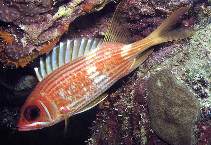| Family: |
Holocentridae (Squirrelfishes, soldierfishes), subfamily: Holocentrinae |
| Max. size: |
35 cm TL (male/unsexed) |
| Environment: |
reef-associated; marine; depth range 0 - 32 m |
| Distribution: |
Western Atlantic: Bermuda and southern Florida, USA to northern South America and Brazil; throughout the West Indies (Ref. 3724). Antilles, northwestern Gulf of Mexico, Yucatan to Colombia (Ref. 26938). |
| Diagnosis: |
Dorsal spines (total): 11-11; Dorsal soft rays (total): 14-16; Anal spines: 4-4; Anal soft rays: 9-11. Conspicuous white spot behind tip of each dorsal spine (Ref. 26938). Body slender. Upper jaw extending posteriorly to middle of pupil (Ref. 37108). Body bright red or red striped, sometimes blotched (Ref. 7251). Similar in color to H. ascensionis, but each interspinous membrane of dorsal fin with a white spot near margin (Ref. 13442). |
| Biology: |
Nocturnal (Ref. 37108), inhabits clear reefs (Ref. 5217). Found near mouths of caves and holes (Ref. 26938); at night they usually move to sandy areas and grass beds to feed on crabs, shrimps, gastropods and brittle stars (Ref. 3724). Marketed fresh but not popular as a food fish (Ref. 5217). |
| IUCN Red List Status: |
Least Concern (LC); Date assessed: 29 January 2013 Ref. (130435)
|
| Threat to humans: |
reports of ciguatera poisoning |
Source and more info: www.fishbase.org. For personal, classroom, and other internal use only. Not for publication.

